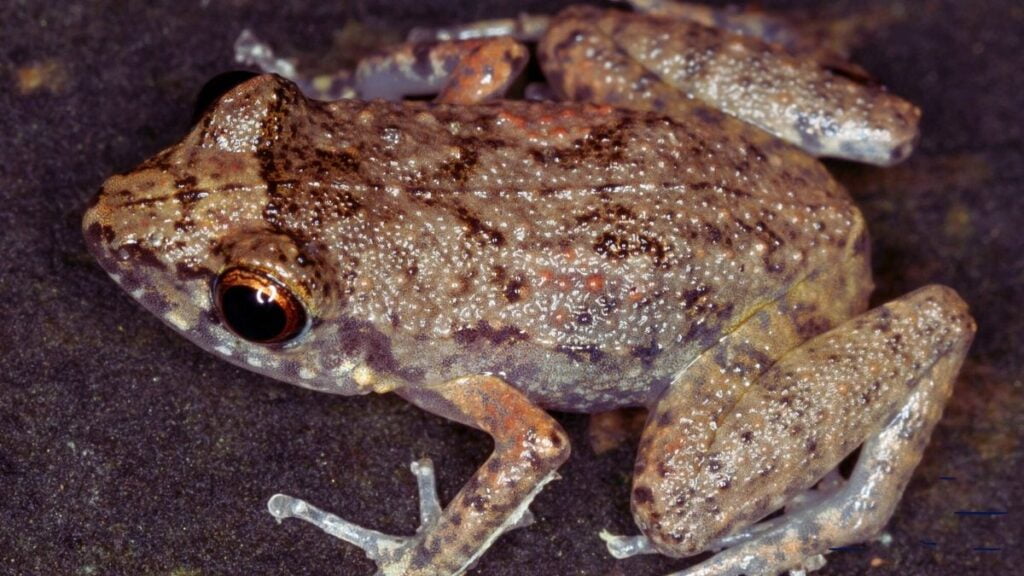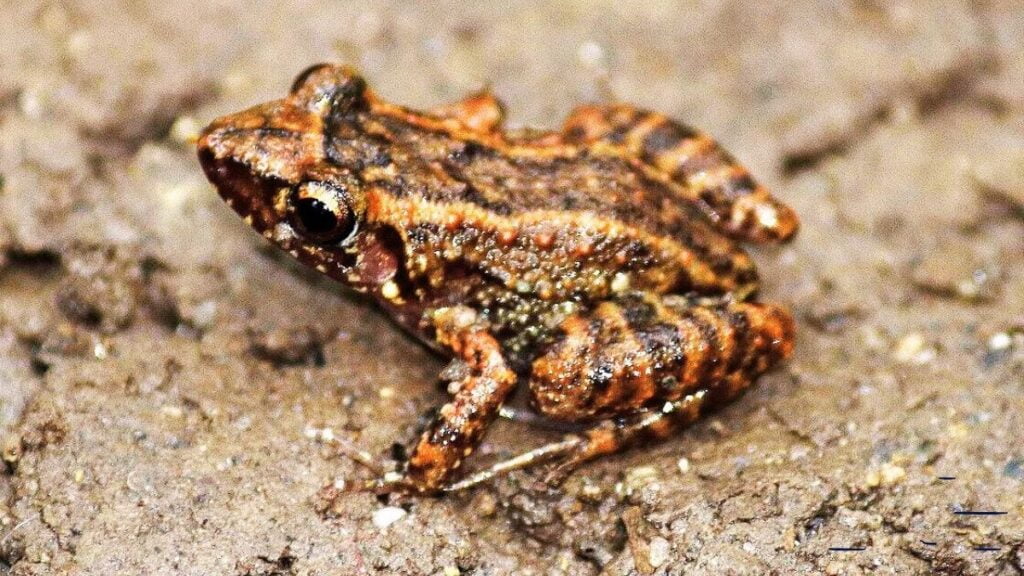Greenhouse frogs are one of the most popular frog species that is native to North America and were later introduced to other continents. But are Greenhouse frogs good pets for beginners? Let’s have a look:

Table of Contents
Everything About Greenhouse Frogs:
In a Glimpse:
| Common Name | Greenhouse Frogs |
| Scientific Name | Eleutherodactylus planirostris |
| Other Names | N/A |
| Maximum Length | 0.7-1.2 inches |
| Maximum Weight | N/A |
| Ranges | North America |
| Habitat | Warm and moist environment |
| Diet | Carnivore |
| IUCN Status | Least Concern |
| Lifespan | N/A |
Geographical Range:
Greenhouse frogs are native to North America. They are usually found in Cuba, the Bahamas, and the Cayman Islands. Later the frog species was introduced in Hawaii and Florida, where it became very common. Now these amphibians are extensively found in southern Georgia, southern Alabama, and eastern Louisiana. In the 2000s, Greenhouse frogs are introduced in Jamaica, Guam, Hong Kong, and Shenzhen (China).
Habitat:
Greenhouse frogs prefer a warm but moist environment to thrive. These frogs are often found near human settlements in leaf litter, logs, and debris along stream banks. Being nocturnal, the frogs are rarely seen during days but on rainy days in summer, you can find them in Florida. In February-March, the species hibernates under the flaking bark of a wild tamarind tree.
Physical Description:

Greenhouse frogs are smaller frog species and the snout-to-vent length of these frogs is 17-31 mm or 0.7-1.2 inches. These frogs have granular skin with a variety of colours such as drab or olive-brown, brown, reddish brown, or bronze with two pattern phases.
The recessive mottled phase has dark brown and light tan coloration often with a v-shaped band on the back and between the eyes. Their underside is paler and with fine brown stippling, and red eyes, and they have slender fingers and toes without webbing but with small terminal toe pads.
Are Greenhouse frogs poisonous?
Greenhouse frogs are not poisonous at all neither they are harmful to humans or dogs by any means. The frog species is one of the safest frog species to consider as pets.
Behaviour:
Greenhouse frogs are nocturnal by nature and are also seen sometimes during the daytime of rainy seasons in Florida. During the daytime of the dry season, they seek shelter in various objects such as wooden logs, mud, sand, etc. During the winter season, the frogs hibernate under the bark of the wild tamarind.
Reproduction:
Greenhouse frogs usually breed during rainy seasons, especially between April and July. Males call females from under debris or from 1 meter below the ground. Males call for mating during the rainy night when the humidity level is almost 90% or above with a soft series of 4 to 5 irregular chirps.

The reproduction technique of these frogs is unique as their eggs are enclosed in a thick membrane in concealed, damp locations, such as under logs, debris, and even under flower pots. The clutch size of eggs varies from 3-26 in Florida and they pass the tadpole stage while they are inside the eggs.
The amphibian species emerge as fully developed juvenile frogs about 5 mm long with short tails that vanish eventually. The tadpoles have “egg teeth” on the end of their snout to help them emerge from the egg case which shed after they came out from the case.
Aggressiveness:
Greenhouse frogs are not aggressive by nature to humans or other animals. Cannibalism is also not seen in the species as adult frogs often guard the eggs and show parental care
Diet:
Greenhouse frogs are completely carnivorous by nature as they feed on small invertebrates such as ants, mites, spiders, beetles, and roaches.
Predators:
Greenhouse frogs show camouflage techniques using their cryptic colouration to avoid predation. Bigger frogs (such as Bullfrogs), lizards, birds, brown tree snakes, Cuban racers, Cuban tree frogs, and ringneck snakes are their main predators.
Conservation Status:
Greenhouse frogs are listed as “Least Concern” in the IUCN Red List of Threatened Species and their population in the wild is increasing.
Lifespan:
There is no information available about the longevity of these frogs.
Are Greenhouse frogs good pets for families?

Greenhouse frogs can be an excellent choice for pets even for beginners and families. These frogs are very calm, and composed, not aggressive or poisonous toward humans or other pets nor do they make much noise. It is easy to prepare an environment that resembles their native place. They are very low-maintenance and easy to take care of frogs and won’t mind if you touch them for a while.
How can you buy a Greenhouse frog?
You can easily find these frogs in illegal pet markets but try to avoid buying them from such places. Frogs that you can find in illegal pet markets, are often illegally caught from the wild and are disease-prone. Also, the process of buying illegally caught frogs is unethical as it promotes illegal hunting and poaching.
Hence it is advised to buy Greenhouse frogs from a reputed pet breeder or a reputed pet shop that can ensure the frog is born and bred in captivity. Also, ask for proof of origin and a health certificate from the breeder or pet shop owner before buying the frog.
You can also check out online platforms to purchase these frogs but check their reviews, policies, and other important information before purchasing. You may have to pay around $5-$20 for every Greenhouse frog depending on their size, age, availability, and your location.
Requirements and Care:
Enclosure:

A 10-gallon terrarium tank with a secure lid and proper ventilation system will be sufficient to accommodate two adult Greenhouse frogs. Unlike other frogs, they are not cannibalistic, and hence you can place multiple frogs in the same container. Just ensure the frogs have enough space between them.
You also need a water dish to provide the frogs with food and water every day. You need some live or artificial trees so the frogs can hide and communicate. It is better to use artificial trees because they are easier to clean and don’t generate waste like live plants. 50% of the tank should be filled with water and the rest area will be land that is separated through a barrier.
Substrate:
Any substrate either natural or artificial that can hold moisture will be suitable for the frogs. The only problem with artificial substrates is that you cannot grow live plants on them. Just ensure the substrate is clean and pollutant free or it’ll react with the frogs and harm them.
You can use peat moss or sphagnum moss as a substrate because they are very good at holding moisture levels. Additionally, you can use coco fibre or a mix of moist soil and coco fibre with the substrate. For the aquatic part, it is advised to use some small gravels that the frogs cannot swallow because these gravels provide a place to hide and also work as coussin.
Temperature and Humidity:
Warm temperatures and highly humid environments are preferable for Greenhouse frogs to thrive and reproduce. Any temperature between 70°F and 80°F and a humidity level of at least 80% is perfect for the frogs. It is very important to keep an eye on the temperature and humidity level because overheating or overcooling the tank can cause significant damage to the frogs. You can use a digital thermometer and hygrometer with an LED screen placed inside the tank, that will help you to track the temperature and humidity.
If, the enclosure is cold, use a heat lamp or heat mat to warm up the tank but avoid overheating because it is very difficult to cool down the temperature. If the humidity level decreases, you can use a mist maker or fogger or you can sprinkle water several times a day to maintain humidity level.
Light:
You can use a low-wattage UVA/UVB light to provide them with sufficient light and vitamin D that they don’t receive from sunlight. Also, remember such lights often increase the temperature of the tank and hence monitor the temperature level to avoid overheating.
Food and Water:

50% of the tank must be filled with dechlorinated water which is free from impurities or pollutants. Otherwise, they might harm the frogs. 50% of the water must be changed daily and filled with fresh water.
Greenhouse frogs are smaller and they don’t need a lot of food to thrive. Feeding them two or three gut-loaded crickets, wax worms, mealworms, or super worms every other day will be sufficient. However, once a week dust their food with proper vitamin and calcium supplements to provide them with proper nutrition.
Handling:
Greenhouse frogs are one of the most calm and gentle frogs to be considered as pets. These frogs are neither poisonous nor aggressive towards humans or other pets. If you touch them for a while they won’t mind but touching them frequently without any purpose can cause them stress and as a result, they might show aggression.
Cleaning:
Cleaning is very important to protect your Greenhouse frogs from any kind of bacterial or fungal growth. You need to change water daily and clean the water dish, dead insects, and waste food from the enclosure regularly to prevent any bacterial or parasite attack.
Once in two weeks deep clean the tank with a mild disinfectant and rinse it thoroughly with dechlorinated water. Ensure the disinfectant is not toxic for amphibians. You don’t need to change the substrate often unless it smells bad.
Remember with proper care and nutrition, a Greenhouse frog can live much longer. A stressed frog is often attacked by parasites and fungi and lives less than a healthy frog.
Reference: Greenhouse frogs on Wikipedia
Also Read: Western Chorus Frogs: Are Midland Chorus Frogs Good Pets?
Also Read: Are Common Surinam Toads Suitable Pets For Beginners?
– Is it ethical to keep wild animals such as Greenhouse frogs as pets, considering their natural habitat and the potential stress of captivity on the animals?
– Should we be promoting the idea of keeping Greenhouse frogs as pets, when they may be better off in their natural environment?
– What impact does the pet trade have on wild populations of Greenhouse frogs, and is it sustainable in the long term?
We recommend not to pet a greenhouse frog which is happy in its natural habitat. But there are frogs those are in animal rescue centers often don’t get enough care and foods. If you want to pet any greenhouse frog, make sure you get it from animal rescue centers because we believe the frog will live happier with you compared to the rescue centers.